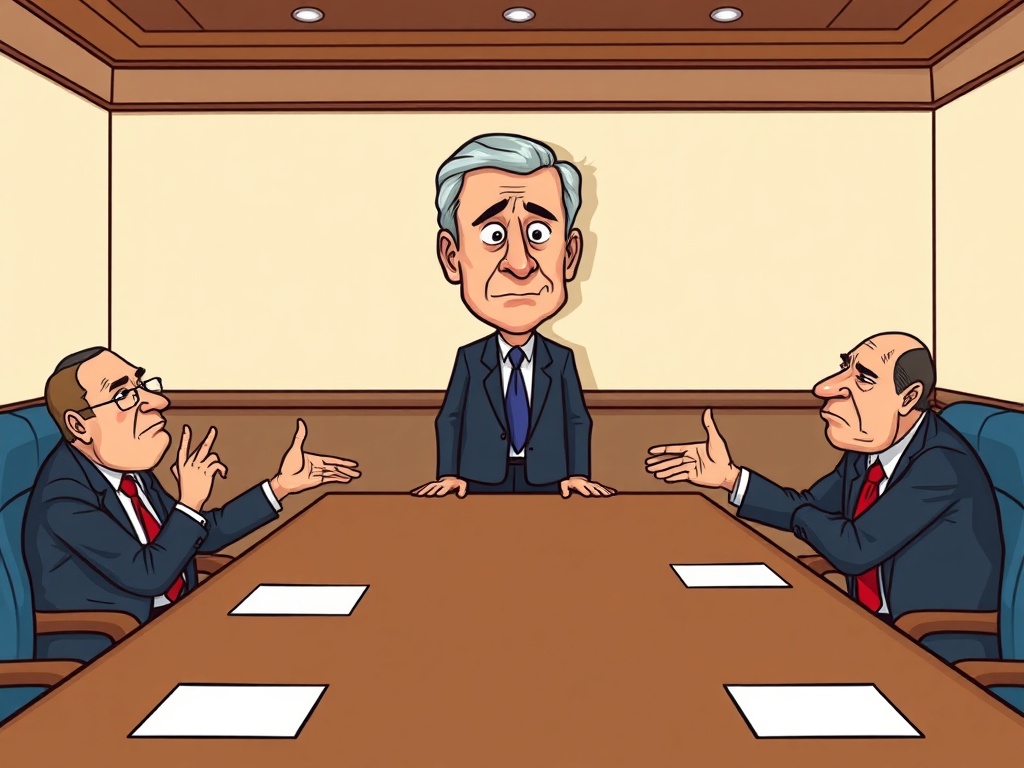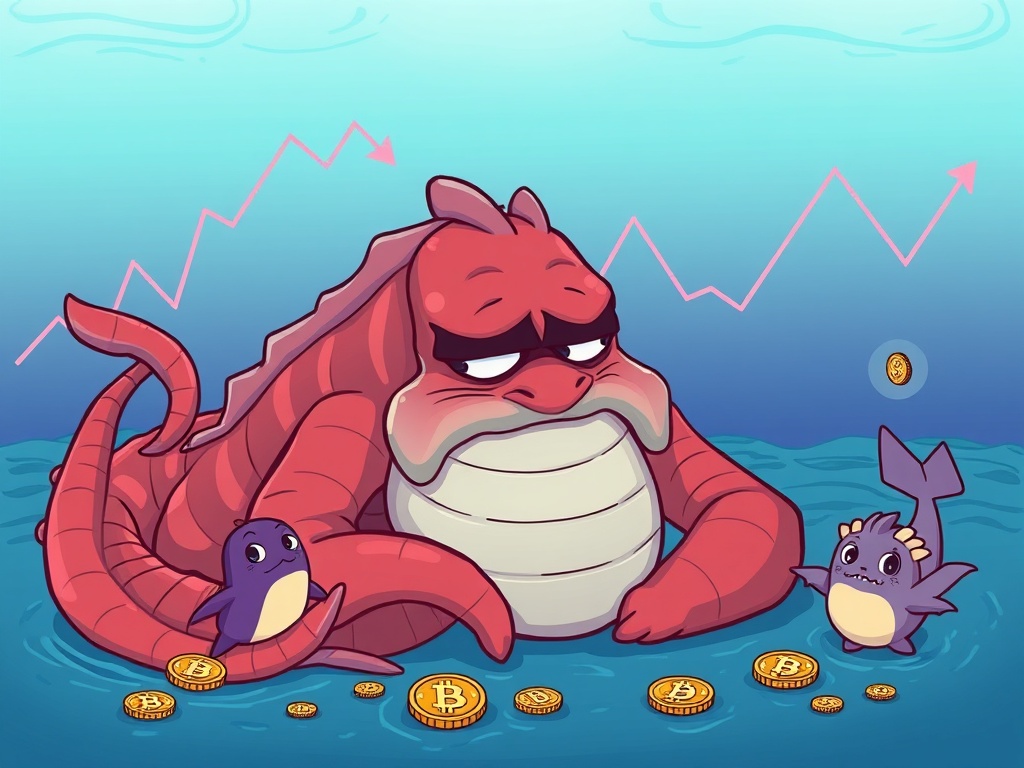BitcoinWorld

Historic Federal Reserve Dissent: A Crucial Shift in Policy?
In the dynamic world of finance, where every whisper from a central bank can send ripples across global markets, an unprecedented event is brewing that could redefine the landscape of U.S. monetary policy. For the first time since 1993, the United States Federal Reserve may witness a significant public dissent from multiple governors, challenging the long-standing consensus under Chair Jerome Powell. This isn’t just a procedural blip; it’s a potential watershed moment that demands attention from investors, economists, and anyone tracking the pulse of the global economy, including the volatile cryptocurrency markets.
Understanding the Potential for Federal Reserve Dissent
The Federal Reserve, often simply called ‘the Fed,’ operates with a carefully cultivated image of unity and consensus. Decisions, particularly those concerning interest rates, are typically reached through robust debate behind closed doors, culminating in a largely unified public statement. This approach is designed to provide clarity and stability to markets, avoiding confusion or speculation about internal divisions.
The Federal Open Market Committee (FOMC) is the monetary policymaking body of the Federal Reserve System. It comprises twelve members: the seven members of the Board of Governors of the Federal Reserve System; the president of the Federal Reserve Bank of New York; and presidents of four other Federal Reserve Banks on a rotating basis. While discussions are often lively, open dissent from multiple governors is exceptionally rare. The last instance of more than one governor dissenting from the Chair’s proposed policy came nearly three decades ago, in 1993. This historical context underscores the gravity of the current situation.
A dissent isn’t merely a disagreement; it’s a formal, public vote against the majority decision. When it comes from multiple governors, it signals a deeper fracture within the committee, potentially indicating differing views on the economic outlook, inflation targets, or the appropriate tools to manage the nation’s finances. Such a development can erode market confidence in the Fed’s unified direction and its ability to steer the economy effectively.
Why is This Federal Reserve Dissent So Significant?
The significance of a multi-governor dissent from the Federal Reserve Chair cannot be overstated. It touches upon several critical aspects of central banking and economic governance:
- Erosion of Consensus: The Fed prides itself on making decisions by consensus to project a strong, unified front. Multiple dissents suggest a breakdown in this consensus, which can lead to uncertainty in financial markets.
- Impact on Credibility: A fractured Fed could be perceived as less effective or less predictable, potentially undermining its credibility as the steward of monetary policy. This can affect how markets interpret future guidance.
- Challenges to Independence: The Fed’s independence from political influence is a cornerstone of its effectiveness. When governors appointed by a particular administration echo that administration’s calls for specific policies, it raises questions about the Fed’s autonomy.
- Policy Direction: Dissent indicates a fundamental disagreement over the direction of monetary policy. If some governors believe rate cuts are necessary while the Chair favors holding steady, it signals differing views on the health of the economy or the urgency of intervention.
Historically, significant dissents have often preceded shifts in monetary policy or periods of increased market volatility. While a dissent doesn’t automatically mean a policy reversal, it introduces a new layer of complexity and uncertainty into the Fed’s decision-making process.
The Players: Powell, Waller, Bowman, and Trump’s Influence on the Federal Reserve
At the heart of this potential confrontation are several key figures, each bringing their own perspectives and influences to the Federal Reserve’s policy table.
Jerome Powell: As the current Chair of the Federal Reserve, Powell has consistently advocated for a steady hand in monetary policy, often emphasizing data-driven decisions and a cautious approach to interest rate adjustments. His leadership has aimed at balancing inflation control with employment goals, navigating complex economic currents with a preference for stability.
Christopher Waller: Appointed by former U.S. President Donald Trump, Christopher Waller has emerged as a vocal proponent for rate cuts. His recent statements have openly aligned with the previous administration’s calls for looser monetary policy, suggesting a willingness to deviate from the more conservative stance often favored by the Chair. Notably, Waller has also publicly stated his readiness to lead the Fed if asked by Trump, further highlighting his political alignment.
Michelle Bowman: Also a Trump appointee, Michelle Bowman has similarly expressed support for rate cuts. Her perspective often emphasizes the need to support economic growth through more accommodative monetary conditions, aligning with the sentiment for lower borrowing costs.
Donald Trump’s Influence: The former president’s repeated and often public criticisms of the Federal Reserve’s interest rate policies during his term put immense pressure on the institution. The fact that his appointees are now echoing his calls for rate cuts underscores the lasting impact of political appointments on the Fed’s internal dynamics. While the Fed strives for independence, the composition of its board is inherently influenced by presidential appointments, which can lead to differing economic philosophies among its members.
This confluence of differing viewpoints sets the stage for a compelling showdown at the upcoming FOMC meeting. The outcome will not only reflect the current state of economic thought within the Fed but also signal the extent to which external political pressures might be influencing its decisions.
What Could This Federal Reserve Dissent Mean for the Markets?
The potential for a multi-governor dissent within the Federal Reserve carries significant implications for various financial markets, creating ripples that could affect everything from bond yields to cryptocurrency prices.
Traditional Markets:
- Stocks: Uncertainty around Fed policy can lead to increased volatility. If the dissent signals a greater likelihood of future rate cuts (due to the dissenting voices gaining traction), it could initially be seen as positive for equities, as lower rates typically reduce borrowing costs for companies and make future earnings more valuable. However, if the dissent highlights deep divisions, it could cause investor apprehension.
- Bonds: Bond markets are highly sensitive to interest rate expectations. A move towards rate cuts would likely push bond yields lower, as existing bonds with higher yields become more attractive. Conversely, if the dissent is interpreted as a sign of policy paralysis, it could lead to uncertainty and potentially higher yields if investors demand more compensation for risk.
- U.S. Dollar: Interest rate differentials are a key driver of currency values. If the Fed is perceived to be moving towards rate cuts, or if its policy direction becomes unclear, the U.S. dollar could weaken against other major currencies, as investors seek higher yields elsewhere.
Cryptocurrency Markets:
While not directly controlled by the Federal Reserve, cryptocurrency markets are indirectly influenced by broader macroeconomic trends and monetary policy decisions:
- Risk Appetite: Looser monetary policy (lower interest rates, increased liquidity) generally fosters a ‘risk-on’ environment. In such an environment, investors might be more inclined to allocate capital to higher-risk assets like cryptocurrencies, potentially driving up prices.
- Inflation Hedges: If the dissent leads to perceptions of a less disciplined Fed or concerns about future inflation (due to more accommodative policies), some investors might turn to Bitcoin and other cryptocurrencies as a hedge against fiat currency devaluation.
- Dollar Weakness: A weaker U.S. dollar, often a consequence of rate cuts or uncertainty, can make dollar-denominated assets like Bitcoin more attractive to international investors.
- Uncertainty and Volatility: Conversely, any sign of instability or deep division within the Federal Reserve could lead to overall market uncertainty, which can trigger sell-offs across all asset classes, including cryptocurrencies, as investors flock to safety.
Investors should closely monitor the language of the FOMC statement and the subsequent press conference. Any hints of a shift in the Fed’s forward guidance, or a prolonged period of internal disagreement, could significantly impact market sentiment and asset valuations across the board.
Looking Ahead: The July 30th FOMC Meeting and Beyond for the Federal Reserve
All eyes are now fixed on the upcoming Federal Open Market Committee (FOMC) statement and interest rate decision, scheduled for July 30 at 18:00 UTC. This meeting is not just another date on the financial calendar; it’s a potential flashpoint for the future direction of U.S. monetary policy.
What should observers and market participants be watching for?
- The Vote Count: The most immediate indicator will be the number of dissenting votes. If more than one governor formally dissents, it will confirm the WSJ report and signal a significant break from recent norms.
- The FOMC Statement Language: Pay close attention to any subtle shifts in the statement’s wording regarding the economic outlook, inflation, and future policy guidance. Even minor changes can be highly indicative of internal debates.
- Jerome Powell’s Press Conference: Following the statement, Chair Powell’s press conference will be crucial. His responses to questions about internal disagreements, the rationale behind the majority decision, and his outlook on future policy will provide invaluable insights.
- Economic Projections: While not always released at every meeting, any updated economic projections (e.g., on GDP, inflation, unemployment, and the ‘dot plot’ for interest rates) would offer a clearer picture of the committee’s collective and individual expectations.
Beyond the immediate outcome of the meeting, the longer-term implications of this potential dissent could be profound. It might signal a period of increased internal debate within the Federal Reserve, potentially leading to less predictable policy decisions in the future. For market participants, this means a heightened need for vigilance and adaptability, as the era of unified Fed messaging might be giving way to a more complex and potentially turbulent landscape.
The stability and predictability of the Federal Reserve’s policy decisions are cornerstones of global financial markets. A significant dissent, particularly from multiple governors, challenges this foundation. It forces a re-evaluation of the Fed’s internal dynamics, its resilience to external pressures, and ultimately, its ability to navigate the complex economic challenges ahead. Whether this marks a temporary blip or the beginning of a new chapter for the Federal Reserve, the July 30th meeting is set to be a pivotal moment for the U.S. economy and beyond.
Conclusion: A New Era for the Federal Reserve?
The whispers of a multi-governor dissent within the Federal Reserve, a phenomenon unseen for nearly three decades, signal more than just an internal disagreement; they hint at a potentially pivotal shift in the dynamics of U.S. monetary policy. This rare challenge to Chair Jerome Powell’s consensus-driven approach, fueled by appointees echoing calls for looser policy, underscores the complex interplay between economic data, political influence, and the pursuit of central bank independence. As the financial world braces for the July 30th FOMC decision, the outcome will not only shape immediate market reactions but also set a precedent for how the Federal Reserve navigates internal divisions and external pressures in an increasingly uncertain global economy. This moment calls for careful observation, as the implications for interest rates, market stability, and even the future trajectory of assets like cryptocurrencies could be substantial.
Frequently Asked Questions (FAQs)
Q1: What is the Federal Open Market Committee (FOMC)?
A1: The Federal Open Market Committee (FOMC) is the monetary policymaking body of the Federal Reserve System. It is responsible for setting the federal funds rate target, which influences other interest rates in the economy and impacts economic activity, inflation, and employment.
Q2: Why is dissent rare at the Federal Reserve?
A2: Dissent is rare because the Federal Reserve highly values consensus and a unified public front to ensure clarity and stability in financial markets. Extensive internal debates occur before decisions are finalized, aiming to reach a broad agreement among members.
Q3: How could Fed dissent impact interest rates?
A3: If the dissenters advocate for rate cuts and their views gain traction, it could increase the likelihood of future rate reductions, potentially leading to lower borrowing costs for consumers and businesses. Conversely, if the dissent highlights deep divisions, it could create uncertainty, which might affect long-term rate expectations.
Q4: What does this mean for cryptocurrency markets?
A4: While not directly controlled by the Fed, cryptocurrency markets are influenced by broader macroeconomic trends. A more dovish (rate-cutting) stance from the Fed, potentially indicated by dissent, could create a ‘risk-on’ environment, potentially benefiting cryptocurrencies. Conversely, significant uncertainty or a perception of Fed instability could lead to broader market sell-offs that impact crypto as well.
Q5: Who are Christopher Waller and Michelle Bowman?
A5: Christopher Waller and Michelle Bowman are members of the Federal Reserve’s Board of Governors. Both were appointed by former President Donald Trump and have recently expressed views supporting interest rate cuts, aligning with previous calls from the Trump administration for looser monetary policy.
Q6: What is the significance of the July 30th meeting?
A6: The July 30th FOMC meeting is significant because it’s the next scheduled opportunity for the Federal Reserve to announce its interest rate decision and release its policy statement. Given the reports of potential multi-governor dissent, this meeting will be closely watched for any signs of a fractured consensus and its implications for future monetary policy.
If you found this deep dive into the Federal Reserve’s potential dissent insightful, consider sharing it with your network! Help others understand the crucial shifts happening in global finance by spreading the word on social media.
To learn more about the latest crypto market trends, explore our article on key developments shaping Bitcoin price action.
This post Historic Federal Reserve Dissent: A Crucial Shift in Policy? first appeared on BitcoinWorld and is written by Editorial Team





